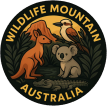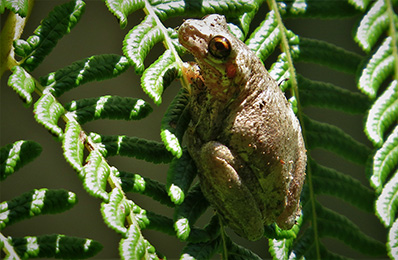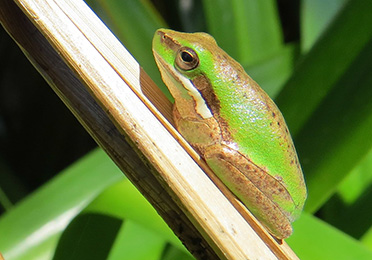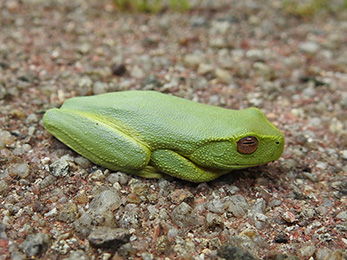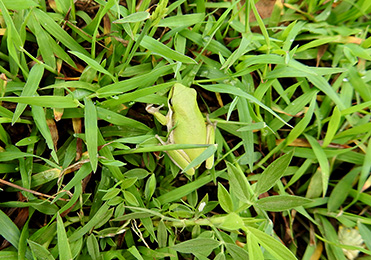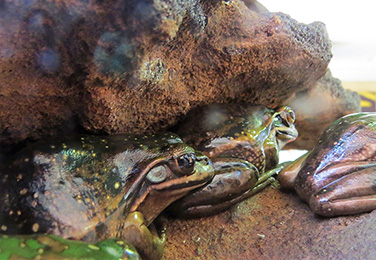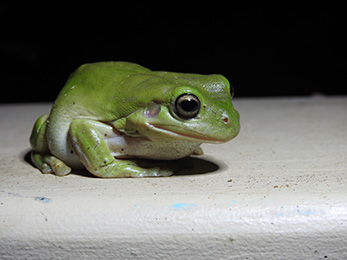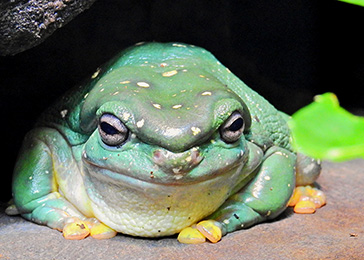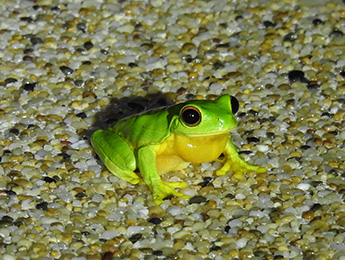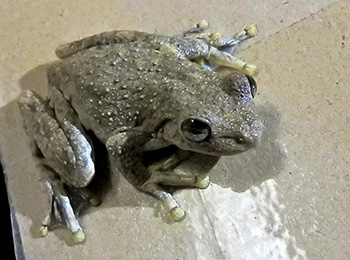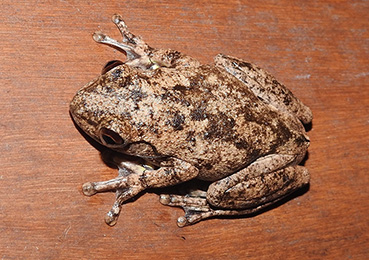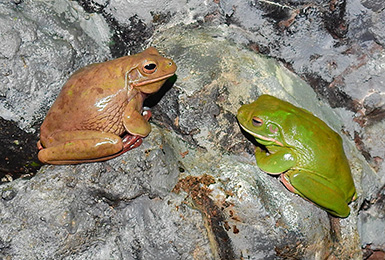AUSTRALIA'S TREE FROGS
Voices in the Canopy: Australia’s Tree Frogs
Step into the rainforest: leaves bead with moisture, the soil breathes a cool, earthy scent, and dusk gathers like a soft curtain. From the vines and paperbark trunks above comes a living soundtrack—notes that ping, chuckle, rattle and roll through the twilight. These are Australia’s tree frogs, and the forest is their stage.
Life in the Trees
Tree frogs are masters of vertical life. Their toe pads act like a blend of suction cup and soft-grip shoe: a thin film of mucus and microscopic structures spread their weight, letting them cling to leaves, glass, and bark. Many wear a cloak of green or mottled brown, shifting shades with light and temperature through skin cells called Chromatophores. It is not just camouflage; it is survival.
- Skin: thin and permeable for
cutaneous respiration, which means they “drink” and exchange gases through their skin. It is why clean, moist microhabitats matter. - Eyes and ears: a protective
nictitating membranekeeps eyes clean, while the external eardrum sits like a coin behind the eye, tuned to the calls of their own kind. - By night: insects and spiders are gleaned from bark and windowsills alike; by day, cool hollows, banana leaves, and even a length of pipe can be a refuge.
The Soundtrack of Survival
Each voice has purpose. Males inflate a vocal sac—a resonant balloon that turns a frog the size of a thumb into a loudspeaker. Calls advertise health, location, and territory. Rain is often the conductor: a first shower can transform a quiet creek line into a full chorus within minutes.
- Mate attraction: rhythm, pitch, and pulse rate help females choose the right species—and the strongest partner.
- Spacing: neighbouring males call-and-answer to share space without a fight.
- Timing: in temperate regions, peak calling follows autumn and spring rains; in the tropics, the wet season is prime time.
A Closer Listen: Who’s Calling?
| Species (Common name) | Call description | Where to listen | Notes |
|---|---|---|---|
| Green Tree Frog (Litoria/Ranoidea caerulea) | Slow, deep “crawk… crawk” and soft grumbles | Northern and eastern Australia, often near houses | A hardy urban adapter; shelter-loving and iconic |
| Eastern Dwarf Tree Frog (Litoria fallax) | High, tinkling “tink… tink… trrr” | East-coast reed beds, ponds, gardens | Tiny body, big chorus; often first to colonise new ponds |
| Peron’s Tree Frog (Litoria peronii) | Rapid, rising cackle—almost laughter | South-east forests and suburbs | Can change colour; emerald speckles in bright light |
| Red-eyed Tree Frog (Litoria chloris) | Sharp “bok-bok-bok,” accelerating | Eastern rainforests and wet sclerophyll | Scarlet eyes, lime body; loves wet nights |
| White-lipped Tree Frog (Litoria infrafrenata) | Loud, resonant “crawk,” dog-like | Cape York and rainforest edges | World’s largest tree frog |
| Green and Golden Bell Frog (Litoria/Ranoidea aurea) | Deep growl with clucks | Coastal NSW and scattered inland sites | Threatened in many areas; sun-basks, loves warm ponds |
| Graceful Tree Frog (Litoria gracilenta) | Light rattle, short bursts | Coastal QLD to northern NSW | Lime green with orange thigh flashes |
| Bleating Tree Frog (Litoria dentata) | Piercing, toy-like squeak | Coastal NSW–QLD, suburbs and farms | One of the loudest small frogs |
Water, Time and Transformation
After rain, many tree frogs lay eggs in still water—flooded grass, pond edges, even tree hollows that hold a pocket of rain. Tadpoles graze algae and detritus, then metamorphose into froglets over weeks to months, depending on temperature, food, and species. In the north, monsoon cycles set the tempo; further south, autumn and spring rains cue the change.
Why Tree Frogs Matter
- Insect control: they moderate mosquitoes, moths, and other invertebrates.
- Food web links: they feed birds, snakes, water rats, and even larger frogs.
- Environmental indicators: because their skin is permeable and their life touches both water and land, declines often signal trouble—pollution, disease, or climate stress.
Challenges in a Changing World
- Habitat loss and fragmentation: fewer hollow logs, wetlands, and shaded edges in towns and farms.
- Pollutants: pesticides, fertilisers, and contaminated stormwater can harm eggs and tadpoles.
- Disease: the
chytrid fungus(Batrachochytrium dendrobatidis) has driven severe declines in some species. - Climate change: altered rainfall and heat extremes dry breeding pools and shelter sites.
- Invasive predators: fish like Gambusia eat eggs and tadpoles; cane toads compete and poison predators.
- Light and noise: artificial light can disrupt calling and feeding; constant noise masks calls.
Helping Tree Frogs at Home
- Create a fish-free pond: shallow edges, varied depths, and a gentle ramp for escape. Add native rushes, sedges, and floating plants. Keep water chemical-free.
- Build a “frog hotel”: stand upright lengths of smooth pipe (about 40–65 mm diameter) in a bucket or pot with water and leaf litter. Place in dappled shade. Tree frogs use the cool, vertical tubes as day shelters.
- Plant structure: layered natives—grasses, shrubs, and small trees—plus leaf litter and logs for cover.
- Reduce chemicals: avoid pesticides and fertilisers; use physical pest controls instead.
- Keep cats indoors at night; supervise dogs around ponds.
- Mind the lights: limit bright night lighting near gardens and wetlands.
- Prevent disease spread: never move frogs or tadpoles between water bodies. Clean boots and gear between sites. Do not release pet frogs.
- Join citizen science: record calls with FrogID (Australian Museum) or local FrogWatch programs to help map populations.
If you must assist a stranded frog, handle as little as possible with rinsed, wet hands or a clean, damp container; their skin absorbs oils, soaps, and sunscreen.
A Gentle Note on Pets
Native frogs are protected. In some states, keeping certain species requires a licence and must be from captive-bred stock only. Wild-caught frogs should never be taken or traded. Good husbandry includes correct humidity, temperature, and disease precautions—seek expert guidance and follow your state’s regulations.
Listen Closely
On a warm, damp evening, pause by a pond or roadside wetland. Let the chorus settle around you: the deep bell of a green tree frog, the quicksilver tinkle of dwarf tree frogs threading through the reeds, the wild cackle of Peron’s tree frog echoing from a gum. In those layered voices is a portrait of place—resilient, intricate, and worth safeguarding. Protect the chorus, and the forest keeps singing.
You can help join the fight to save the frogs of Australia !
